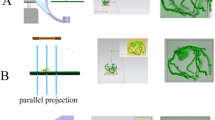Abstract
Purpose
In coronary angiography, the condition of myocardial blood supply is assessed by analyzing 2-D X-ray projections of contrasted coronary arteries. This is done using a flexible C-arm system. Due to the X-ray immanent dimensionality reduction projecting the 3-D scene onto a 2-D image, the viewpoint is critical to guarantee an appropriate view onto the affected artery and, thus, enable reliable diagnosis. In this work, we introduce an algorithm computing optimal viewpoints for the assessment of coronary arteries without the need for 3-D models.
Methods
We introduce the concept of optimal viewpoint planning solely based on a single angiographic X-ray image. The subsequent viewpoint is computed such that it is rotated precisely around a vessel, while minimizing foreshortening.
Results
Our algorithm reduces foreshortening substantially compared to the input view and completely eliminates it for \(90^{\circ }\) rotations. Rotations around isocentered foreshortening-free vessels passing the isocenter are exact. The precision, however, decreases when the vessel is off-centered or foreshortened. We evaluate worst-case boundaries, providing insight in the maximal inaccuracies to be expected. This can be utilized to design viewpoints guaranteeing desired requirements, e.g., a true rotation around the vessel of at minimum \(30^{\circ }\). In addition, a phantom study is performed investigating the impact of input views to 3-D quantitative coronary angiography (QCA).
Conclusion
We introduce an algorithm for optimal viewpoint planning from a single angiographic X-ray image. The quality of the second viewpoint—i.e., vessel foreshortening and true rotation around vessel—depends on the first viewpoint selected by the physician; however, our computed viewpoint is guaranteed to reduce the initial foreshortening. Our novel approach uses fluoroscopy images only and, thus, seamlessly integrates with the current clinical workflow for coronary assessment. In addition, it can be implemented in the QCA workflow without increasing user interaction, making vessel-shape reconstruction more stable by standardizing viewpoints.





Similar content being viewed by others
References
Blinn J (1977) A homogeneous formulation for lines in 3 space. In Siggraph 1977, pp 237–241. Association for Computing Machinery, Inc
Chrisriaens J, Walle R, Lemahieu I (2001) A simple determination system for optimal angiographic viewing. Conf Image Process 2:327–330
Chen S, Carroll J (2000) 3-D reconstruction of coronary arterial tree to optimize angiographic visualization. Tans Med Imaging 19(4):318–336
Delaere D, Smets C, Suetens P, Marchal G, Van de Werf F (1991) Knowledge-based system for the three-dimensional reconstruction of blood vessels from two angiographic projections. MBEC 29(6):NS27–NS36
Fallavollita P, Winkler A, Habert S, Wucherer P, Stefan P, Mansour R, Ghotbi R, Navab N (2014) Desired-view controlled positioning of angiographic c-arms. In MICCAI, pp 659–666. Springer
Garcia J, Movassaghi B, Casserly I, Klein A, Chen S, Messenger J, Hansgen A, Wink O, Groves B, Carroll J (2009) Determination of optimal viewing regions for X-ray coronary angiography based on a quantitative analysis of 3D reconstructed models. Cardiovasc Imaging 25(5):455–462
Green N, Chen S, Hansgen A, Messenger J, Groves B, Carroll J (2005) Angiographic views used for percutaneous coronary interventions: a three-dimensional analysis of physician-determined vs. computer-generated views. Catheter Cardiovasc Interv 64(4):451–459
Liu I, Sun Y (1992) Fully automated reconstruction of three-dimensional vascular tree structures from two orthogonal views using computational algorithms and productionrules. Opt Eng 31(10):2197–2208
Mozaffarian D, Benjamin E, Go A, Arnett D, Blaha M, Cushman M, Howard V (2015) Executive summary: heart disease and stroke statistics 2015 update. Circulation 131(4):434–441
Pellot C, Sigelle M, Horain P, Peronneau P (1994) A 3D reconstruction of vascular structures from two X-ray angiograms using an adapted simulated annealing algorithm. TMI 13(1):48–60
Sato Y, Araki T, Hanayama M, Naito H, Tamura S (1998) A viewpoint determination system for stenosis diagnosis and quantification in coronary angiographic image acquisition. TMI 17(1):121–37
Tu S, Koning G, Jukema W, Reiber JH (2010) Assessment of obstruction length and optimal viewing angle from biplane x-ray angiograms. Int J Cardiovasc Imaging 26(1):5–17
Unberath M, Taubmann O, Hell M, Achenbach S, Maier A (2017) Symmetry, outliers, and geodesics in coronary artery centerline reconstruction from rotational angiography. Medical Physics 44(11):5672–5685
Virga S, Dogeanu V, Fallavollita P, Ghotbi R, Navab N, Demirci S (2015) Optimal c-arm positioning for aortic interventions. In BVM 2015, pp 53–58. Springer
Wink O, Kemkers R, Chen S, Carroll JD (2002) Coronary intervention planning using hybrid 3d reconstruction. In MICCAI, pp 604–611. Springer
Acknowledgements
The concepts and information presented in this paper are based on research and are not commercially available.
Author information
Authors and Affiliations
Corresponding author
Ethics declarations
Conflict of interest
S. Achenbach, M. Unberath and A. Maier have no conflict of interest. A. Preuhs is funded by Siemens Healthcare GmbH, Forchheim Germany. M. Berger, S. Bauer and T. Redel are employees of Siemens Healthcare GmbH, Forchheim Germany.
Informed consent
This article does not contain patient data.
Rights and permissions
About this article
Cite this article
Preuhs, A., Berger, M., Bauer, S. et al. Viewpoint planning for quantitative coronary angiography. Int J CARS 13, 1159–1167 (2018). https://doi.org/10.1007/s11548-018-1763-1
Received:
Accepted:
Published:
Issue Date:
DOI: https://doi.org/10.1007/s11548-018-1763-1




